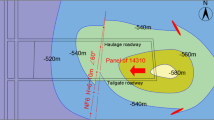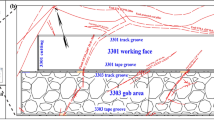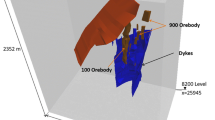Abstract
Faults are one of the most common geological structures in underground mining. Affected by mining activities, fault-slip events will release large amounts of energy and trigger seismic waves, which could induce rock burst events and endanger mining operations. In this study, a longwall panel intersecting with a fault is introduced, as well as field microseismic (MS) monitoring. Static and dynamic numerical analyses are conducted to investigate the fault parameters’ effects on the behaviors of the fault. The results show that the friction angle (φf) significantly affects the shear displacement, magnitude and distribution of the seismic moment; the fault stiffness has a great effect on the magnitude of the seismic moment but smaller effects on the shear displacement and the distribution of the seismic moments. Based on the influence of the fault stiffness and φf on the seismic moment, reasonable fault parameters can be determined. By employing the calibrated parameters, the dynamic responses and the rock burst potential of the surrounding rocks were analyzed by means of the peak particle velocity (PPV) and stress distribution. The propagation of the seismic waves released by fault-slip events excites the particle velocity of the rock mass, and there is a strong correlation between the particle velocity and rock mass damage. As the working face advances toward the fault, the PPV and stress fluctuation of the peak abutment stress rise significantly, which result in a great increase in the rock burst potential. The rock burst potential changes with the mining activities; therefore, corresponding measures must be applied to prevent and control rock burst events. This study contributes to deepening our understanding of the fault parameters in numerical simulations and the dynamic responses and rock burst potential of the surrounding rocks due to mining activities and provides a back-analysis calibration method for the fault parameters.




















Similar content being viewed by others
Abbreviations
- L :
-
Distance of the working face from the fault
- H :
-
Distance of the fault from the coal seam roof
- M 0 :
-
Seismic moment
- G :
-
Shear stiffness
- A :
-
Area of the fault where shear slip occurs
- D :
-
Shear displacement
- M c :
-
Cumulative seismic moment
- E i :
-
Elastic modulus
- υ :
-
Poisson’s ratio
- c :
-
Cohesion
- σ t :
-
Tensile strength
- φ f :
-
Friction angle
- F smax :
-
Maximum shear force
- F s :
-
Shear force
- c if :
-
Contact surface cohesion
- A i :
-
Area represented by the contact surface node
- F n :
-
Normal force
- μ :
-
Pore pressure
- PPV:
-
Peak particle velocity
- σ p :
-
Peak abutment stress
References
ABAQUS (2003) ABAQUS online documentation: ver 64–1. Dassault Systemes, Paris
Alber M, Fritschen R (2011) Rock mechanical analysis of a M1 = 4.0 seismic event induced by mining in the Saar district, Germany. Geophys J Int 186:359–372
Barton N (1973) Review of a new shear-strength criterion for rock joints. Eng Geol 7(4):287–332
Barton N, Choubey V (1977) The shear strength of rock joints in theory and practice. Rock Mech 10(1–2):1–54
Bizzarri A (2012) Rupture speed and slip velocity: what can we learn from simulated earthquakes? Earth Planet Sci Lett 317:196–203
Blake W, Hedley DGF (2004) Rockbursts: case studies from American hard-rock mines. Society for mining, metallurgy, and exploration, Littleton
Brinkmann JR (1987) Separating shock wave and gas expansion breakage mechanism. In: 2nd International Symposium on Rock Fragmentation by Blasting, pp 6–15
Domański B, Gibowicz SJ (2008) Comparison of source parameters estimated in the frequency and time domains for seismic events at the Rudna copper mine, Poland. Acta Geophys 56(2):324–343
Feng F, Li XB, Rostami J et al (2019a) Numerical investigation of hard rock strength and fracturing under polyaxial compression based on Mogi-Coulomb failure criterion. Int J Geomech 19(4):04019005
Feng F, Chen SJ, Li DY et al (2019b) Analysis of fractures of a hard rock specimen via unloading of central hole with different sectional shapes. Energy Sci Eng. https://doi.org/10.1002/ESE3.432
Fu MX, Liu SW, Jia HS, He DY (2019) Experimental study of an orientation and resin‑Lifting device for Improving the performance of resin‑anchored roof bolts. Rock Mech Rock Eng. https://doi.org/10.1007/s00603-019-01906-5
Hedley DGF (1992) Rockburst handbook for Ontario hard rock mines. Ontario Mining Association, North York
Hofmann GF, Scheepers LJ (2011) Simulating fault slip areas of mining induced seismic tremors using static boundary element numerical modelling. Min Technol 120(1):53–64
Hosseini N (2017) Evaluation of the rockburst potential in longwall coal mining using passive seismic velocity tomography and image subtraction technique. J Seismol 21:1101–1110
Itasca (2009) FLAC3D-fast Lagrangian analysis of continua. Itasca Consulting Group Inc, Washington
Ivins ER, Lyzenga GA (1986) Stress patterns in an interplate shear zone: an effective anisotropic model and implications for the transverse ranges, california. Philos Trans R Soc B Biol Sci 318(1542):285–347
Ji HG, Ma HS, Wang JA, Zhang YH, Cao H (2012) Mining disturbance effect and mining arrangement analysis of near-fault mining in high tectonic stress region. Saf Sci 50(4):649–654
Jiang LS, Wang P, Zhang PP, Zheng PQ, Xu B (2017) Numerical analysis of the effects induced by normal faults and dip angles on rock bursts. CR Mech 345:690–705
Jiang LS, Kong P, Shu JM et al (2019a) Numerical analysis of support designs based on a case study of a longwall entry. Rock Mech Rock Eng. https://doi.org/10.1007/s00603-018-1728-2
Jiang LS, Wu QS, Wu QL et al (2019b) Fracture failure analysis of hard and thick key layer and its dynamic response characteristics. Eng Fail Anal 98:118–130
Kaiser PK, Cai M (2012) Design of rock support system under rockburst condition. J Rock Mech Geotech Eng 4(3):215–227
Kong P, Jiang L, Shu J et al (2019) Effect of fracture heterogeneity on rock mass stability in a highly heterogeneous underground roadway. Rock Mech Rock Eng. https://doi.org/10.1007/s00603-019-01887-5
Konicek P, Soucek K, Stas L, Singh R (2013) Long-hole distress blasting for rockburst control during deep underground coal mining. Int J Rock Mech Min Sci 61:141–153
Li CC (2010) A new energy-absorbing bolt for rock support in high stress rock masses. Int J Rock Mech Min 47(3):396–404
Li T, Mu ZL, Liu GJ, Du JL, Lu H (2016a) Stress spatial evolution law and rockburst danger induced by coal mining in fault zone. Int J Min Sci Technol 26(3):409–415
Li ZL, Dou LM, Cai W, Wang GF, Ding YL, Kong Y (2016b) Roadway stagger layout for effective control of gob-side rock bursts in the longwall mining of a thick coal seam. Rock Mech Rock Eng 49(2):621–629
Li YC, Sun SY, Tang CA (2019) Analytical prediction of the shear behaviour of rock joints with quantified waviness and unevenness through wavelet analysis. Rock Mech Rock Eng. https://doi.org/10.1007/s00603-019-01817-5
Manouchehrian A, Cai M (2018) Numerical modeling of rockburst near fault zones in deep tunnels. Tunn Undergr Sp Technol 80:164–180
Mazaira A, Konicek P (2015) Intense rockburst impacts in deep underground construction and their prevention. Can Geotech J 52(10):1426–1439
Meng FZ, Louis NYW, Zhou H, Wang ZQ (2018) Comparative study on dynamic shear behavior and failure mechanism of two types of granite joint. Eng Geol 245:356–369
Mutke G, Lurka A, Dubinski J (2009) Seismic monitoring and rock burst hazard assessment in deep polish coal mines-case study of rock burst on April 16, 2008 in Wujek-Slask coal mine. In: International symposium on rockburst and seismicity in mines
Mutke G, Dubiński Józef, Lurka Adam (2015) New criteria to assess seismic and rock burst hazard in coal mines. Arch Min Sci 60(3):743–760
Ortlepp WD, Stacey TR (1994) Rockburst mechanisms in tunnels and shafts. Tunn Undergr Sp Technol 9(1):59–65
Peng SS (2008) Coal mine ground control, 3rd edn. Peng SS Publisher, Morgantown
Sainoki A, Mitri HS (2014a) Dynamic modelling of fault-slip with barton’s shear strength model. Int J Rock Mech Min 67(67):155–163
Sainoki A, Mitri HS (2014b) Dynamic behaviour of mining-induced fault slip. Int J Rock Mech Min 66(1):19–29
Sainoki A, Mitri HS (2016) Back analysis of fault-slip in burst prone environment. J Appl Geophys 134:159–171
Sainoki A, Mitri HS (2017) Influence of mining activities on the reactivation of a footwall fault. Arab J Geosci 10(5):99
Stewart RA, Reimold WU, Charlesworth EG, Ortlepp WD (2001) The nature of a deformation zone and fault rock related to a recent rockburst at western deep levels gold mine, Witwatersrand basin, south africa. Tectonophysics 337(3–4):173–190
Wang X, Cai M (2017) Numerical modeling of seismic wave propagation and ground motion in underground mines. Tunn Undergr Sp Technol 68:211–230
Wang SY, Lam KC, Au SK, Tang CA, Zhu WC, Yang TH (2006) Analytical and numerical study on the pillar rockbursts mechanism. Rock Mech Rock Eng 39(5):445–467
Wang P, Jiang L, Zheng P (2017) Application of equivalent materials to modeling fractures in the vicinity of a normal fault in the area of mining exploitation influence. Acta Geodyn Geomater 14(4):475–485
Wang GF, Gong SY, Dou LM, Cai W, Yuan XY, Fan CJ (2019) Rockburst mechanism and control in coal seam with both syncline and hard strata. Saf Sci 115:320–328
Weng L, Huang L, Taheri A et al (2017) Rockburst characteristics and numerical simulation based on a strain energy density index: a case study of a roadway in linglong gold mine, china. Tunn Undergr Sp Tech 69:223–232
Wu QS (2017) Study on the law mining stress evolution and fault activation under the influence of normal fault. Acta Geodyn Geomater 14(3):357–369
Wu QH, Chen L, Shen BT et al (2019) Experimental investigation on rockbolt performance under the tension load. Rock Mech and Rock Eng 52:4605–4618
Zhang JF, Jiang FX, Yang JB, Bai WS, Zhang L (2017) Rockburst mechanism in soft coal seam within deep coal mines. Int J Min Sci Technol 27(3):551–556
Zhang ZZ, Yu XY, Wu H et al (2019) Stability control for gob-side entry retaining with supercritical retained entry width in thick coal seam Longwall mining. Energies 12(7):1375. https://doi.org/10.3390/en12071375
Zhao TB, Guo WY, Tan YL, Yin YC, Cai LS, Pan JF (2018) Case studies of rock bursts under complicated geological conditions during multi-seam mining at a depth of 800 m. Rock Mech Rock Eng 51:1539–1564
Acknowledgements
The research of this study was sponsored by the National Natural Science Foundation of China (51704182, 51774194), the Natural Science Foundation of Shandong Province (ZR2017BEE050, ZR2017BEE045), the State Key Laboratory for Geomechanics and Deep Underground Engineering (SKLGDUEK1725) and the Shandong University of Science and Technology, and the Graduate Innovation Fund of Shandong University of Science and Technology (SDKDYC190344).
Author information
Authors and Affiliations
Corresponding author
Ethics declarations
Conflict of Interest
The authors declare that they have no conflicts of interest.
Additional information
Publisher's Note
Springer Nature remains neutral with regard to jurisdictional claims in published maps and institutional affiliations.
Rights and permissions
About this article
Cite this article
Jiang, L., Kong, P., Zhang, P. et al. Dynamic Analysis of the Rock Burst Potential of a Longwall Panel Intersecting with a Fault. Rock Mech Rock Eng 53, 1737–1754 (2020). https://doi.org/10.1007/s00603-019-02004-2
Received:
Accepted:
Published:
Issue Date:
DOI: https://doi.org/10.1007/s00603-019-02004-2




